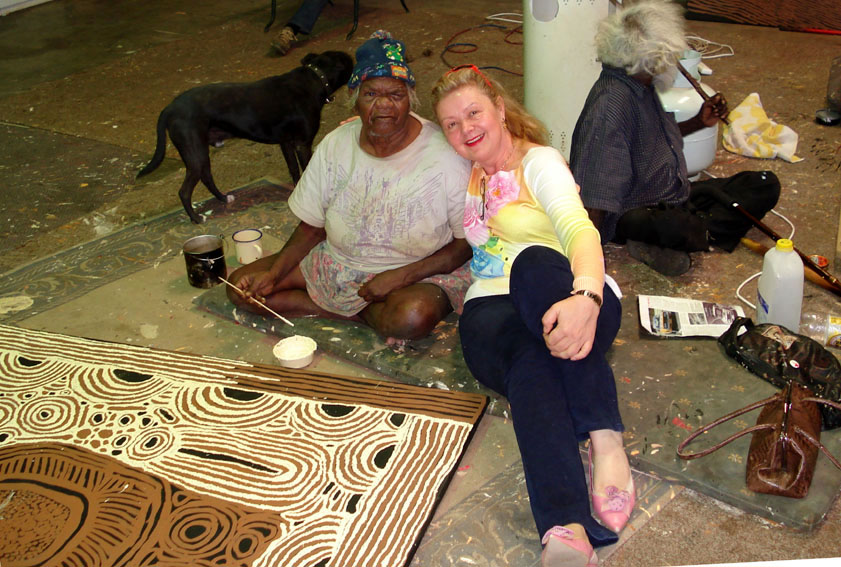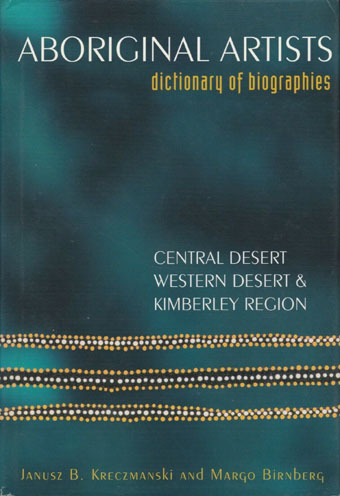|
.png)
Nyurapayia
Nampitjinpa
Biography
1935-2013
Nyurapayia
Nampitjinpa
aka Mrs Bennett
(1935-2013)
is
a renowned Australian
Aboriginal
artist.
The World's Art experts praised Nyurapayia Nampitjinpa work classifying
as state-of-the-art, unique, ground-breaking, dynamic and extremely
powerful.
Nyurapayia was
instrumental in the Haasts Bluff-Kintore Women's Painting
Camp
development
(1994).
Nyurapayia Nampitjinpa work
is held in
Art Gallery of South Australia,
Art Gallery of NSW,
NGA,
National Gallery of Victoria,
NGA collection
and
prestigious
collections
around the world including
National
Gallery of Victoria,
Museum Art Gallery of the Northern Territory,
National
Museum of Australia,
Queensland Art
Gallery,
Art Gallery of
Western
Australia.
Work of
Nyurapayia
Nampitjinpa
is
highly praised
in the
World Art market,
Kapi
Tjukurrpa
sold for
$41,480,
Untitled 2007
$50,400,
Untitled 2005
sold for $45,900
and
Punkilpirri
sold for $72,000,

PHOTO
(2006):
Nyurapayia Nampitjinpa aka Mrs. Bennett
(work in progress) her masterwork painting
MRSB200615
Nyurapayia was a major participant in the Kintore-Haasts Bluff collaborative canvas project titled "Minyma Tjukurrpa" in 1994
and the Tandanya National Aboriginal Cultural Institute in 1995.
Mrs Bennett was instrumental in the development of the Haasts
Bluff/Kintore Women's Painting Camp in 1994, she
was
the commanding figure among today's western desert women artists, a painter of
the utmost force and will.
Nyurapayia Nampitjinpa
inherited her mother's dreamings, which are connected to sites at
Yumarra, Wantjunga and Tjalilli, rockholes near Papunya, Pukara, Ngalkinginga
and Munkara.
Nyurapayia
Nampitjinpa lived in Kintore
however, she has
developed a free and original style in contrast to artists in
Kintore who prefer the very precise dot-painting method.
Mrs. Bennett
paintings
depicts
a series of locations associated with Nyurapayia’s traditional homeland.
The
concentric circles represent sacred waterholes which are not only a
reliable source of water but also significant ceremony sites used for
the purpose of initiation.
It is here that the senior women associated
with the location referred to as “Punkilpirri” prepared for ceremonial
rituals.
The delineation of carious aspects of the land is represented
by a series of parallel and oblique lines. These include the sand
country referred to as “tali” and the rocky outcrops known as “puli”
Both of these environments.
Nyurapayia Nampitjinpa
aka
Mrs. Bennett
work is represented around the world
including
Kelton Foundation Santa Monica
USA,
Art Bank Sydney,
Art Gallery of New South Wales,
Museum and Art Gallery of
the Northern Territory,
National Gallery of Victoria,
National Museum of Australia,
Art Gallery of South Australia,
National Art Gallery of
Queensland,
Homes a Court collection,
Art Gallery of Western Australia,
Donald Kahn Collection USA.
Nyurapayia Nampitjinpa
aka Mrs Bennett was married to the late John John Tjapangati Bennett, a Pintupi speaker from Mukulurru, also north of
Docker River.
Mrs.
Bennett
and Kintore women camped at the roc-khole site of Yumarra, near Tjukula
in Western Australia. The roundels show the camp sites of the women who
had travelled from Punkilpirri, a large permanent water site, north-west
of Docker River in the Walter James Range. They later continued their
travels to the north through Tjukula and Tjalili.
While at Yumarra the
women performed the ceremonies associated with the area. They also
gathered the edible berries and seeds growing in the vicinity. The "U"
shapes in this painting show women camped at the rockhole site of
Yumarra, south of the large permanent warter site of Punkilpirri, north
of Docker River. The women later travelled north to Punkilpirri and
Tjukula. As they travelled they gathered the edible berries known as
kampurarrpa or desert raisin from the small shrub Solanum centrale.
AWARDS
Nyurapayia Nampitjinpa aka
Mrs. Bennett is one of the most
important Australian Aboriginal artists.
1994
Nyurapayia was a
participant in the Kintore-Haasts Bluff collaborative canvas project in
1994. This resulted in an exhibition titled Minyma Tjukurrpa and
was held at the Tandanya National Aboriginal Cultural Institute in 1995.
1999
Other exhibitions of her works include ‘Twenty-five Years and Beyond’
(1999) and Australia Perspective (1999). Nyurapayia favors the use of
strong contrasts using blacks and pale yellows/creams set in relief
against a red ground. Her designs are based on the stories relating to
women’s ceremony and often depict the gathering of traditional bush
foods and the rituals that are connected with their preparation. The
depictions of the sand dune country and surrounding rocky outcrops bear
a relationship to the designs used for body painting during the
ceremonial dance referred to as “inma”.
The remote Pangkupirri rock holes, a set of clear
pools deep in the western desert's Walter James Range, are not well
known in metropolitan Australia.
But perhaps they should be, and one day
will be: their sheer, red walls, the pinnacles and crags that surround
them and the rivulets that flow from them are this continent's
equivalent of the Saint-Remy gardens or the Mont Sainte-Victoire- a
defining artistic landscape, associated with a single master.
2001
Nyurapayia Nampitjinpa (aka
Mrs Bennett)
was named among the top 50
of Australia's Most Collectable Artists in March 2001 issue
of Australian Art Collector.
2010
For Pangkupirri is the constantly depicted subject of "Mrs Bennett",
Nyurapaia Nampitjinpa, the commanding figure among today's western
desert women artists, a painter of the utmost force and will. The
Australian February 15, 2010.
2011
Mrs. Bennett
was named the top 50 Australia's most Collectable Artists.
2013
Recognized as
Australian national
treasure, Nyurapayia Nampitjinpa
passed away 28 January 2013.
Nyurapayia Nampitjinpa, artist of a universe of song and desert law
(1 Feb
2013)
Mrs. Bennett
emanated the
ground-breaking,
dynamic,
own
unique
style of painting in
the
contrast to other Kintore artists,
is
one of the most
contemporary,
the
state-of-the-art.
Nyurapayia Nampitjinpa, known as
Mrs. Bennett, helped shape
the Aboriginal women's painting movement.
2014
The
Art of Nyurapayia Nampitjinpa (Mrs Bennett)
by
Ken McGregor, Ralph
Hobbs, The Art of Nyurapayia Nampitjinpa (Mrs Bennett), Macmillan
Art Publishing, 2014, p. 84 (illus.).
Having been exhibited widely
across Australia, Singapore and Germany, Mrs Bennett's work
is included in the collections of the
National Gallery of
Australia, Canberra,
The Art Gallery of NSW, Art Gallery of
the Northern Territory, National Gallery of Victoria,
Artbank and in corporate and private collections
internationally.
Mrs Bennett loved the strong contrasts using blacks and pale
yellows/creams set in relief often against a red ground.
Mrs.
Bennett
designs were based on the stories relating to women's
ceremony and regularly depicted the gathering of traditional
bush foods and the rituals connected with their preparation.
The depictions of the sand dune country and surrounding
rocky outcrops bear a relationship to the designs used for
body painting during the ceremonial dance referred to as 'inma'.
Mrs. Bennett painted her
mother's Dreamings which are connected to sites at Yumarra,
Wantjunga and Tjalilli rockholes near Papunya, Pukara,
Ngalkinginga and Munkara rockholes. She was deeply concerned
with women's culture, and her designs often depicted women's
ceremonies and rituals. The gathering of bush tucker such as
Kampurarrpa (desert raisin) and quandong are also central
themes.
Mrs Bennett passed away on January 28th 2013 near her
ancestral land of Punkilpirri.
Nyurapayia Nampitjinpa was born at Yumarra. In the early hours of Monday,
28 January 2013, in the far reaches of her ancestral country, Nyurapayia Nampitjinpa
aka Mrs. Bennett,
the most forceful and overwhelming of the first western desert artists, reached
the end of her remarkable life.
Nyurapayia Nampitjinpa aka
Mrs. Bennett
(Mon
28th January 2013).
COLLECTIONS
National Gallery of
Australia, Canberra
National Gallery of Australia, Melbourne
ArtBank, Sydney
Art Gallery of NSW, Sydney
Museum and Art Gallery of the Northern Territory, Darwin
National Gallery of Victoria, Melbourne
National Museum of Australia
Art Gallery of South Australia, Adelaide
Queensland Art Gallery, Brisbane
Homes a Court Collection, Perth
Art Gallery of Western Australia, Perth
Kelton Foundation, Santa Monica, USA
Artbank, Sydney
Donald Kahn Collection USA
Aboriginal art is the most important contemporary art to come
out of this ancient land.
Each painting tells a story as well as having an imposing decorative
element to the art work.
Aboriginal art is part of a living tradition
and as the culture goes through a transition, major changes are taking
place in the aboriginal communities and people move to the towns
learning western ways.
The artist’s age thus it is probably the last
chance that anyone on this planet can buy such authentic indigenous work
of art.
Aboriginal paintings are
powerful works
of art that look superb in modern buildings and they signify, for the
people who display them a connection with the present as well as the
past. You have an opportunity to purchase the work of the mature,
established artists who have had an original traditional aboriginal
upbringing.
Alternative link :
http://www.theaustralian.com.au/news/arts/on-the-united-colours-of-bennett/story-e6frg8n6-1225830244462
.png)
EXHIBITIONS
2007 Papunya Tula, Short Street Gallery, Broome, Western Australia,
Australia.
2007 Papunya Tula Women, Suzanne O'Connell Gallery, Brisbane,
Queensland, Australia.
2007 Survey-Group show of emerging artists, Raft Artspace, Darwin,
Northern Territory, Australia.
2007 The Black And White Show, Red Dot Gallery, Singapore.
2006 Yawulyurru kapalilu palyara nintilpayi, Papunya Tula Artists, Alice
Springs, NT
2006 Paintings By Papunya Tula Artists, Suzanne O'Connell Gallery,
Brisbane, QLD
2006 A Particular Collection, Utopia Art Sydney, NSW
2006 Pintubi Dreaming, Red Dot Gallery, Singapore
2006 Land Marks, National Gallery of Victoria, Melbourne, Vic
2006 Across The Board, Utopia Art Sydney, NSW
2004 The Inner and the Outer, Stadtgalerie Bamberg, Villa Dessauer,
Bamberg, Germany
2004 All About The Papunya, Chapman Gallery, Canberra, ACT
2004 Woolloongabba Art Gallery, Brisbane, QLD
2004 Works From Kintore and Kiwirrkura, Alison Kelly Gallery, Melbourne,
Vic
2004 Kuniya Pilkati, Gallery Gabrielle Pizzi, Melbourne, Vic
2003 Christmas Gift Exhibition, Alcaston Gallery, Melbourne, Vic
2003 Pintupi Art From The Western Desert, Indigenart, Subiaco, WA
2003 Aboriginal Art 2003, Scott Livesey Art Dealer, Melbourne, Vic
2002 Next Generation - Aboriginal Art 2002, Art House Gallery, Sydney,
NSW
2002 Paintings From Our country, Tony Bond Aboriginal Art Dealer,
Adelaide, SA
2002 Twenty Five Years and Beyond - Papunya Tula Painting, Academy of
the Arts, University
of Tasmania, Tasmania
2002 Twenty Five Years and Beyond - Papunya Tula Painting, Brisbane City
Gallery, QLD
2002 Scott Livesey Art Dealer, Melbourne, Vic
2002 Pintupi Mens' and Womens' Stories, Indigenart, Subiaco, WA
2002 Pintupi Artists, Papunya Tula Artists, Alice Springs, NT
2001 Palm Beach Art Fair, Palm Beach, Florida, USA
2001 Art House Gallery, Sydney, NSW
2001 Papunya Tula 2001, William Mora Galleries, Melbourne, Vic
2001 Art of the Pintupi, Tony Bond Aboriginal Art Dealer, Adelaide, SA
2001 Papunya Tula Women, William Mora Galleries, Melbourne, Vic
2001 Twenty Five Years and Beyond - Papunya Tula Painting, The Araluen
Centre, Alice Springs
2001 Indigenart, Subiaco, WA
2001 Pintupi Exhibition, Papunya Tula Artists, Alice Springs, NT
2001 Pintupi Women From Kintore, Fireworks Gallery, Brisbane, QLD
2001 Size Doesn't Matter, William Mora Galleries, Melbourne, Vic
2000 Utopia Art, Sydney, NSW
2000 Aboriginal Art, Aboriginal Art Gallerie Bahr, Speyer, Germany
2000 Aboriginal Art 2000, Scott Livesey Gallery, Armadale, Vic
2000 Papunya Tula - Genesis and Genius, Art Gallery of New South Wales,
Sydney, NSW
2000 17th National Aboriginal and Torres Strait Islander Art Award,
Darwin, NT
2000 Framed Gallery, Darwin, NT
2000 Pintupi Women - Papunya Tula Artists, Alice Springs, NT
1999 Utopia Art, Sydney, NSW
1999 Twenty Five Years and Beyond - Papunya Tula Painting, Flinders
University Art Museum,
Flinders University, Bedford Park, SA
1996 Papunya Tula Artists Pty. Ltd. Alice Springs, NT
1996 Utopia Art, Sydney, NSW
1996 C.A.A.A.C.E, Araluen Art Centre, Alice Springs, NT
|
Literature
Source
& FURTHER
REFERENCES

Australian
Aboriginal Artist dictionary of biographies
Kreczmanski, Janusz B and Birnberg, Margo (eds.): Aboriginal
Artists: Dictionary of Biographies: Central Desert, Western
Desert and Kimberley Region JB Publishing Australia, Marleston,
2004.
Aboriginal Artists of the Western Desert - A Biographical
Dictionary by Vivien Johnson, published by Craftsman House 1994
The Oxford Companion to Aboriginal Art and Culture edited by
Sylvia Kleinert and Margo Neale published by OUP 2000
Aboriginal Artists: Dictionary of Biographies: Central Desert,
Western Desert & Kimberley Region JB Publishing Australia,
Marleston, 2004
Brody, A. 1989 Utopia women’s Paintings: the First Works on
Canvas, A summer Project, 1988-89 exhib. Cat. Heytesbury
Holdings, Perth Brody
A.
1990 Utopia, a picture Story, 88 Silk Batiks from the Robert
Homes a Court Gallery and gallery Collection, Heytesbury
Holdings LTD Perth NATSIVAD database, Latz, P. 1995, Bushfires &
Bushtucker, IAD Press, Alice Springs
Brody, A. 1989 Utopia women’s Paintings: the First Works on
Canvas, A summer Project 1988-89 exhib. Cat. Heytesbury
Holdings, Perth Brody
Amadio,
N. und Kimber, R., Wildbird Dreaming. Aboriginal Art from the
Central Deserts of Australia, Greenhouse Publ., Melbourne 1988;
Auckland City Art Gallery, Auckland 1990, Ausst. Kat.;
Australian Aboriginal Art from the Collection of Donald Kahn.
Lowe Art Museum, University of Miami (Hrsg.), 1991, Ausst. Kat.;
Droombeelden - Tjukurrpa. Groninger Museum (Hrsg.), Groningen
1995, Ausst. Kat.; Isaacs, J., Australia´s Living Heritage. Arts
of the Dreaming, Lansdowne Press, Sydney 1984; Isaacs, J.,
Australian Aboriginal Paintings. Lansdowne, Sydney 1989, ISBN
186302011X; Johnson, V., Aboriginal Artists of the Western
Desert. A Biographical Dictionary, Craftsman House, East
Roseville 1994, ISBN 9768097817; Modern Art - Ancient Icon. The
Aboriginal Gallery of Dreamings (Hrsg.), o.O. 1992, ISBN
0646080520; Nangara. The Australian Aboriginal Art Exhibition
from the Ebes Collection. The Aboriginal Gallery of Dreamings (Hrsg.),
Melbourne 1996, Ausst. Kat.; Stourton, P. Corbally, Songlines
and Dreamings. Lund Humphries Publ., London 1996, ISBN
0853316910; The Painted Dream. Contemporary Aboriginal
Paintings. Johnson, V. (Hrsg.), Auckland City Art Gallery,
Auckland 1991, Ausst. Kat.; Tjinytjilpa. The Dotted Design.
Aboriginal Art Galleries of Australia (Hrsg.), Melbourne 1998,
Ausst. Kat.; Traumzeit - Tjukurrpa. Kunst der Aborigines der
Western Desert. Die Donald Kahn-Sammlung, Danzker, J.B. (Hrsg.),
Prestel, München und New York 1994, Ausst. Kat.; Voices of the
Earth. Paintings, Photography and Sculpture from Aboriginal
Australia. Gabrielle Pizzi (Hrsg.), Gallery Gabrielle Pizzi,
Melbourne 1996, Ausst. Kat., ISBN 0646288954. |




|